March 18, 2010
The Seventh quarterly report... and the other Six
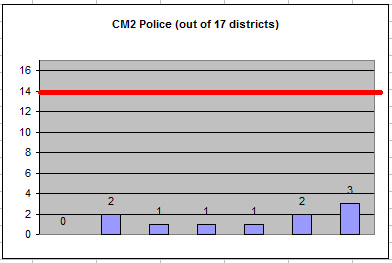 The Seventh annual Canadian quarterly report on our Afghan mission is out, and others have already commented on the apparent lack of progress over three months ago on the ANSF side... something that has been mentioned here, oh, now and again.
The Seventh annual Canadian quarterly report on our Afghan mission is out, and others have already commented on the apparent lack of progress over three months ago on the ANSF side... something that has been mentioned here, oh, now and again.
Anyway, to take a better look on actual trends over the last 18 months of this reporting, I've charted the six objective ANSF benchmark measures on the flip side, so you can see the progress since they were established as part of the government's response to the Manley Commission in June 2008.
In all cases, the red line is the Canadian government's stated goal.
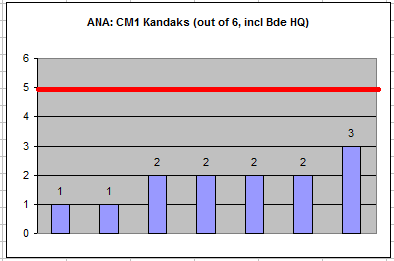 First up is the number of kandaks out of the five in 1/205 ANA Brigade plus brigade HQ rated at Capability Milestone 1. 5 Kandak, the logistics kandak joined 2 Kandak and the HQ at that level a few months ago. While one can quibble about what CM1 really means in terms of capability, this is what an on-track benchmark at the halfway point (between mid-2008 and mid-2011) should look like.
First up is the number of kandaks out of the five in 1/205 ANA Brigade plus brigade HQ rated at Capability Milestone 1. 5 Kandak, the logistics kandak joined 2 Kandak and the HQ at that level a few months ago. While one can quibble about what CM1 really means in terms of capability, this is what an on-track benchmark at the halfway point (between mid-2008 and mid-2011) should look like.
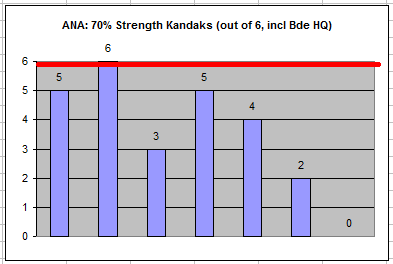 Effective strength of the ANA, on the other hand, is not being maintained at the Canadian government goal of 70% for all kandaks. To be fair, though, it was expected that 2009 would be a loss year for 1 Brigade as a lot of its original enlistments from when its units were first formed were coming to term this year. Insisting on more accurate and rigorous reporting from the ANA is probably another factor that has hurt this metric while actually helping the war effort.
Effective strength of the ANA, on the other hand, is not being maintained at the Canadian government goal of 70% for all kandaks. To be fair, though, it was expected that 2009 would be a loss year for 1 Brigade as a lot of its original enlistments from when its units were first formed were coming to term this year. Insisting on more accurate and rigorous reporting from the ANA is probably another factor that has hurt this metric while actually helping the war effort.
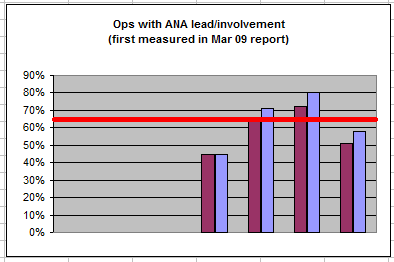 The third measure, % of operations with an ANA lead or involvement in the Canadian sector has also dropped. It replaced an earlier metric, so there's only a year's worth of data. This has always been the most subjective of these measures (Do you count a resupply run? A traffic checkpoint? An IED sweep? Is a battalion operation worth the same as a patrol?), and the idea that 45% of the actual military activity in the area was led by the ANA, the reported number during my stay in the brigade HQ which was supposedly doing all that work, was always difficult to credit as anything more than someone somewhere playing with numbers. The reporting was simply too sketchy for us to totally rely on, too: if the ANA said they did a patrol, and no Canadians participated, did you take their word for it and counted it in the stats? That means the "executed" figure (light purple, the percent of all activities in which the ANA participated somehow) is probably the more useful of the two.
The third measure, % of operations with an ANA lead or involvement in the Canadian sector has also dropped. It replaced an earlier metric, so there's only a year's worth of data. This has always been the most subjective of these measures (Do you count a resupply run? A traffic checkpoint? An IED sweep? Is a battalion operation worth the same as a patrol?), and the idea that 45% of the actual military activity in the area was led by the ANA, the reported number during my stay in the brigade HQ which was supposedly doing all that work, was always difficult to credit as anything more than someone somewhere playing with numbers. The reporting was simply too sketchy for us to totally rely on, too: if the ANA said they did a patrol, and no Canadians participated, did you take their word for it and counted it in the stats? That means the "executed" figure (light purple, the percent of all activities in which the ANA participated somehow) is probably the more useful of the two.
 Our only ANP measure worth tracking, really, is % that have reached Capability Milestone 2, meaning they're largely self-sufficient. That steadfastly refuses to rise as fast as we'd like towards Canada's goal of 14 out of 17 districts. The other metrics in our reporting relate to the Canadian building of infrastructure, and the number of police who have taken FDD training, which is now somewhere above 100% of the total number of police in the province. The ludicrous attrition rate, however, means that the actual number of trained police is much lower than the total complement; no one's sure exactly how low. It's not much of a metric if the number can never go down, and none of the other police metrics can.
Our only ANP measure worth tracking, really, is % that have reached Capability Milestone 2, meaning they're largely self-sufficient. That steadfastly refuses to rise as fast as we'd like towards Canada's goal of 14 out of 17 districts. The other metrics in our reporting relate to the Canadian building of infrastructure, and the number of police who have taken FDD training, which is now somewhere above 100% of the total number of police in the province. The ludicrous attrition rate, however, means that the actual number of trained police is much lower than the total complement; no one's sure exactly how low. It's not much of a metric if the number can never go down, and none of the other police metrics can.
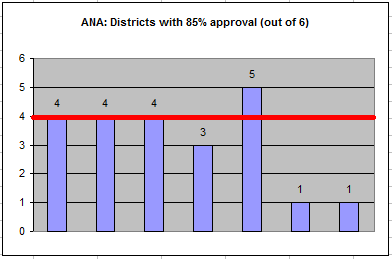 The optimism of early 2008 that the worst might be over is best reflected in the two public opinion metrics. I don't know why someone thought the ANA would need to retain an 85% public approval rating among Kandahar's key districts (I can't think of a single public institution in Canada that has an approval rating that high in peacetime), but that's what we've been tracking. It's hard to see how we could meet it until peace breaks out.
The optimism of early 2008 that the worst might be over is best reflected in the two public opinion metrics. I don't know why someone thought the ANA would need to retain an 85% public approval rating among Kandahar's key districts (I can't think of a single public institution in Canada that has an approval rating that high in peacetime), but that's what we've been tracking. It's hard to see how we could meet it until peace breaks out.
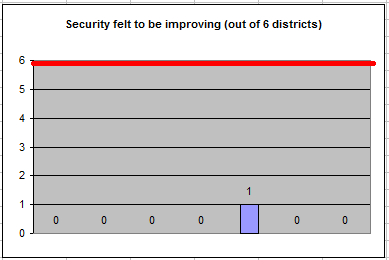 The answer to the "is security improving" poll question is, if anything, even more telling.
The answer to the "is security improving" poll question is, if anything, even more telling.
It's too simple to say we're bad at picking benchmarks. The real trouble here is all these are essentially second-order effects, which can really only go up rapidly once the insurgency wanes. They are not independent of insurgent inputs: in fact the insurgent input in all cases has the potential to dwarf any aggregate Canadian input. We're not measuring our own effectiveness in the battle, right now, in other words, but only confirming the insurgents' are refusing to go away.
Unit CM ratings, for instance, go up when a unit has time to be trained and equipped properly. In a time of heavy insurgent activity, when fighting is more important, ratings which are based on objective subcriteria like manning strength or percent of equipment that's operational will go down due to the wear and tear of war. So really, we're not rating our effect on the Afghan army's ability to fight by these statistics, but the degree to which it is well-run: orthogonal if not antithetical to battlefield success. Local public opinion and AWOL rates are similarly secondary (an army hip-deep fighting a vicious insurgency effectively is guaranteed not going to be able to keep 85% public approval or a 10% AWOL rate). And it goes without saying that the fastest way to get Canadians to step aside and let Afghans run military operations would have been if the insurgents went away for awhile.
We didn't really think through two years ago how we would measure counterinsurgency success in the absence of peace, because it was such a new field for us as a nation. The production of more sophisticated metrics, like Kilcullen wrote about, has lagged behind the war in that sense, and for now we're stuck with metrics that will only look good either if we start belling the numbers, or once peace breaks out. The risk here was always that benchmarks that can really only look good if the Afghans are fighting less (like police CM ratings) could be counterproductive if there's any kind of government pressure to see "progress". So the fact they are flat-lining actually is fairly positive: it shows our government, at least so far, hasn't feel the need to resort to that sort of thing.
Again, it's not that we're not one input; it's that we're just one input of several that affects these figures, so our success is not what's being measured. So in 2009 you had a dramatic shrinking of the area of Kandahar province that Canadian troops were primarily responsible for, and a radically different, pop-centric COIN-y approach adopted (the "key village" strategy). That, along with American reinforcement, means our military operations are on a much sounder footing right now than they were a year ago. But neither of those huge changes in the way Canadians are conducting this war was likely to be measurable in any of these stats, so long as the overwhelming influencer, the insurgents, were still active in large numbers.
The other good news is that this is only the halfway point, that there's another half-dozen quarterly reports like this one to go, and American military investment in Kandahar in that time period (another dependency these stats have that will tend to dwarf our own efforts in the security sector) is likely to lead to all of them trending up in the next few reports anyway. So expect all these metrics to rise somewhat through 2010-2011 as that greater U.S. input is felt. Again, it's not really measuring our own contributions to this fight, though.
Yeah, I was there, it wasn't that bad
Had to look a while for the long version of Murray Brewster's piece reading Canadian Expeditionary Forces Command assessments from my roto. (The Star's abridged version is amusingly titled "Taliban Came Close to Retaking Kandahar". Yeah, no, they didn't. The piece is about how they came close to killing off the provincial council, which is nowhere near the same thing.) Finally found it at the Penticton Herald.
Hamidi, the mayor, was targeted by a roadside bomb the same month.
Yeah, that was an interesting day. Nice mushroom cloud/dust plume, that one. I do quibble with this, though:
That perception was something the Afghan government may have brought upon itself by the firing of Wessaís predecessor, Rahmatullah Raufi, a popular general.
"Politically many Raufi supporters have called for his reinstatement, demonstrating general displeasure with amount of power held by a few individuals in the province," said the quarterly campaign assessment from Oct. 1 to Dec. 8, 2008.
"The removal of Governor Raufi and subsequent replacement with Governor Wessa lends itself to political instability. Violent acts of intimidation directed (censored) impacts governance progress and initiatives."
Within weeks of the firing, the Afghan government lost control of Ghorak district, in the extreme western part of the province.
Absolutely no connection. Ghorak is so isolated from the rest of the province it might as well be the other side of the moon. I doubt anyone in Ghorak could have told you who the governor was, let alone be disappointed by his departure. And Ghorak had been non-permissive to Afghans and ISAF long before the gubernatorial replacement. Just a reporter's coincidence taking the place of causation, there.
Today's essential Afghan reading: Bing West, and Malevich
The inestimable Bing West on the Helmand offensive. He was embedded with an ANA kandak, which really is the only way to see one of these things:
"This sort of small task force, with a ratio was one US to ten Afghans, makes a lot of sense. It's a combat and advisory unit at the same time." (Bingo.)
It is clear that we must provide an air cap for the askars [Dari: "soldiers"] as our combat battalions withdraw. Yes, 60s and 81s have a role in mountains and in flat lands laced with ditches and defilade approaches. But weíre not training the askars in mortars.
Air is the default weapon of choice, and it requires US JTACs on the ground. Thus it would seem advisable to plan now, a year in advance, for the composition (and the motivation) of task forces to work with the kandaks, as Task Force Commando did in Marja. (Exactly.)
Nicholson's rule-of-thumb was eight askars and Americans per patrol on foot, with no requirement for overwatch by a vehicle. ODA loved the lack of restrictions in their sector. The result was 60 patrols a day per battalion. In other provinces, some battalions averaged 24 patrols a day.
That's remarkable. Even American per-battalion patrolling rates for what West continues poor units (24 a day) are significantly higher than Canadian rates in Kandahar Province were during my roto and since (one patrol per company per day in one report). It's hard to escape the conclusion we really hadn't been patrolling as much, compared to the U.S.
A grunt doing seven months can do with less and push harder than when he has to do twelve months. The argument that he makes less meaningful relations with Afghans is shallow. Most grunts don't form relationships because they don't live in the villages, and there is no evidence that twelve months yields better intelligence results. There is ample evidence that twelve months does yield fewer patrols per day.
Canadian rotos are six months (but we still patrol less than those American army units that do 12, apparently). It's a good point about the lack of Afghan relationships at the soldier level, meaning tours for them don't need to be any longer. Different, though for troops in a mentoring role, I would argue.
Rarely is a Talib body recovered after a firefight. Given the ranges of most engagements, itís not clear how many are really killed versus those reported shot.
The statistics I collected during my tour suggested it was MUCH more dangerous for a young man to be an Afghan policeman than it was to be an insurgent. It's not just about the pay.
Even fewer are captured and sent to prison to do hard time. The police fall under the National Directorate of Security. Estimates are that for every ten actual Talibs detained at the substation level, only one will eventually stand trial, be convicted and sent away under the NDS system. There is leakage and corruption at every level. Afghanistan on a per capita basis has fewer criminals (including insurgents) in prison than does Sweden.
On the other hand, Talib recruitment is low. They havenít attracted large numbers of followers, even when they have been in charge for years, as in Marja. But if you are not killing or capturing the enemy in significant numbers, itís hard to win a war.
This is the Kandahar experience, as well, and the flip side of the ongoing detainee debate in Canada. One in ten would be consistent with my experience with Afghan detainees. It appears the repurposing of the Afghan civilian criminal justice system to govern the majority of ANSF detainee operations has not succeeded in any military sense. As Grossman ("On Killing") and Niall Ferguson ("The Pity of War") have both documented, historically, armies that don't take prisoners have to fight a lot harder to achieve the same effect on the enemy. Now, normally, that's because they're evil, unnecessarily cruel mofos. In the case of our ANA allies, it's the practical opposite, but it still makes it very difficult even today for an Afghan insurgent to surrender himself out of the war, which is certainly one of the reasons they've been able to stick around this long.
Also worth it today: a sharp piece from John Malevich on the trouble with the latest "arm the tribes" advocates (Gant, Pressfield, et al):
Jirga/Tribal structure makes planning too slow. It is easily infiltrated and the supporters are too easily identified and targeted with night letters and murder, and of course their plans can be communicated to the enemy quite easily.
...with special appearances in the comments by Malevich AND Gant, along with the usual suspects (Gunslinger, Schmedlap, etc.). My take: Gant and Malevich (and West) are all trying to operationalize a small number of Western soldiers enabling a larger number of armed Afghans in their own way. That is the winning concept. Always has been. Everything else on the military side of this fight is helpful, well-intended noise.
"endearingly macho" -- Mark Steyn
"wonderfully detailed analysis" -- John Allemang, Globe and Mail
"unusually candid" -- Tom Ricks, Foreignpolicy.com
May 2010
April 2010
March 2010
February 2010
January 2010
December 2009
November 2009
October 2009
September 2009
August 2009
July 2009
News:
The Globe and Mail
The Star
The Wash. Post
Opinion:
TNR
Slate
Washington Monthly
Rants:
Canadians
Penny
Janes
Cosh
The Hound
Coyne
Wells
Farrell, etc.
Steyn
Levant
Afghanistan
The Torch
Abu M.
Bill & Bob
Ghosts of Alex
Registan
Jari
Ink Spots
Ackerman
Kings
FRI
Embedded
Milnews.ca
Can-AFG
The Capt.
Etc.
TMLutas
Sullivan
Marshall
Kaus
Lileks
Reynolds
Welch
Farber
The Shark
Breen
Henley
Electrolite
Samizdata
Slotman
Simberg
Northrup
Bryant
Yglesias
Cole
Drum
Clients/Employers
(Past and Present):
U of T
Cdn. Forces
CG Magazine
LRC
Adrenaline Vault
